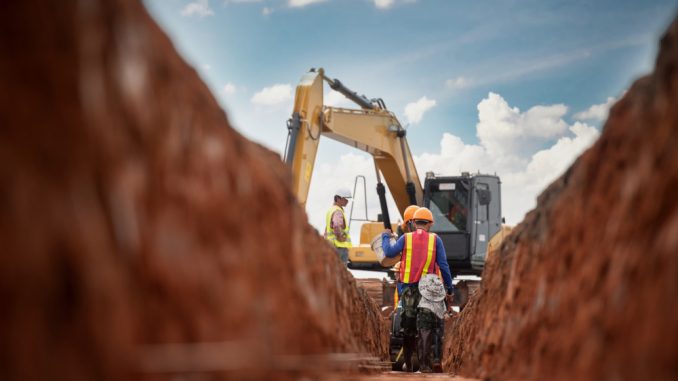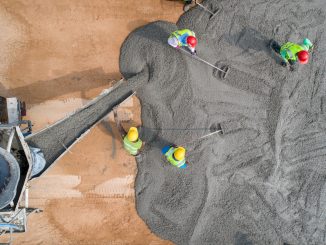
Safety training is critical in the construction industry because it’s a high-risk workplace with hazardous work. Dangerous situations are part of the everyday working environment. The constant challenge for construction companies is to create and deliver effective safety training.
“The traditional way of handling safety training tends to be boring and doesn’t take into account the natural learning style of construction workers,” says Abby Ferri, vice president, national construction practice, Hays Companies, a Minneapolis, Minnesota-based risk management, insurance and employee benefits advisor. “It is more effective to provide hands-on training, and if this can’t be done in the immediate workplace, the training should be done in some sort of a simulation of the workplace or at least do meaningful activities that bring the workplace into the classroom.”
Ferri, who has been actively involved in construction safety for more than 16 years, has found that rather than building a PowerPoint presentation for a particular training topic, it is significantly more effective to determine the learning objectives and goals for the particular training, identify learning activities that can be facilitated with the students (workers) and then guide them through the training. “It is important,” she stresses, “that the training be interactive because this helps to keep everyone involved.
“People being trained need to have the opportunity to share their experiences and bring their on-the-job knowledge to the training,” explains Ferri. “This is an adult learning principle that says adults benefit most from experiences that are problem based and collaborative.”
The trainer needs to digest what is being shared, understand the group that is taking the training and if, necessary, adjust the learning activities – or even the content of the training – to make it appropriate and applicable, she says.
Out and About
Rather than in a classroom setting, Ferri is conducting an “in the field” Safety Tech Trek at the upcoming ICUEE, October 1-3, 2019, in Louisville, Kentucky. She will be walking around the show floor discussing how new equipment and technology can help keep workers safe.
“Despite what some think, technology is for every company,” she maintains. “It’s a matter of finding what technology works with a company’s culture and can supplement that culture, plus make things easier.
“Under the lens of training, if there is technology for the sake of using technology, this may not resonate well with the workers. But technology that helps them do their jobs better, safer and more efficiently will prove beneficial.”
She says these are some of the top construction safety technologies to keep an eye on:
- Wearables and Embedded Technology: This technology involves attaching various types of mobile electronics and embedded sensors to the body and personal protective equipment for a wide range of purposes. These include proximity detection, ergonomics, fatigue, overexertion, stress level monitoring, etc. The result is improved worker and jobsite safety.
- IoT (Internet of Things): By combining the real-time data generated by wearables, embedded technology and GPS tracking with the IoT, Big Data can be used to monitor and measure a wide variety of safety performance metrics within the construction industry. This information can then be used to continuously change and/or strengthen safety programs.
- Enterprise Solutions: These are designed to integrate multiple facets of jobsite safety through the interchange of information from “connected” workers and a “connected” jobsite. With a sensor network onsite and connected workers enabled by technology, workplace safety is improved because these solutions enable workers to transmit and receive information in real time. Additionally, worker productivity is increased due to the continuous interaction between the environment, information and workers.
- Collision Avoidance Systems: Technologies will continue to evolve to further improve construction equipment safety. These include blind-spot coverage, proximity detection alerts, detecting the presence of workers, collision avoidance systems and systems that monitor equipment operators and keep a record of their performance.
- Microlearning: While online safety training has its place, it doesn’t work well for those who work in the field, notes Ferri. Typically, these workers don’t engage with sitting in front of a computer to watch safety training and will not retain much information. More effective is microlearning. Basically, this involves is breaking down information into compact, focused learning segments – usually three to five minutes long – that are designed to meet a specific learning outcome. The training – which can be viewed on a smartphone or tablet in the field – is easier to process and knowledge retention is increased.
- Apps: Mobile applications are making it easier to get safety training and information to workers, plus help safety managers be more efficient and productive.
You can see the latest equipment and technology for the utility and construction industries at ICUEE – The Demo Expo, Oct. 1-3, 2019 in Louisville, KY. Registration is now open.
The biennial ICUEE, International Construction and Utility Equipment Exposition is known as The Demo Expo for its equipment test drives and interactive product demonstrations.
It is the leading event for utilities and utility and construction contractors seeking comprehensive insights into the latest industry technologies, innovations and trends, focused on electric transmission and distribution, telecom, cable, natural gas, water and wastewater and vegetation management.
ICUEE owner and producer is Association of Equipment Manufacturers (AEM), the North American-based international trade group representing off-road equipment manufacturers and suppliers – www,aem.org.












































